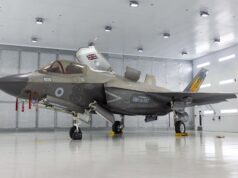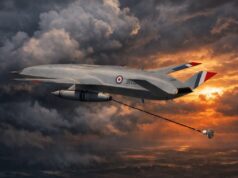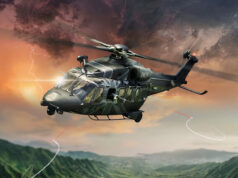Lockheed has hosted a ceremony to celebrate its new F-16 production line in Greenville, South Carolina.
F-16 tooling and equipment previously in Fort Worth, Texas, has since been installed in a newly-refurbished hangar in Greenville, where the company will begin manufacturing F-16 Block 70 aircraft later this year, say the firm.
“This is an exciting time as we celebrate another important milestone for the F-16 ‒ the world’s most successful, combat-proven 4th generation fighter,” said Michele Evans, executive vice president of Lockheed Martin Aeronautics.
“The future is bright, and it begins right here in Greenville, South Carolina ‒ the new home of F-16 production.”
Bahrain became the first F-16 Block 70 customer in June 2018, Slovakia signed Letter of Agreement in Dec. 2018 for 14 Block 70 aircraft, and Bulgaria and the US Government are currently negotiating Bulgaria’s planned acquisition of new F-16 Block 70 aircraft.
The US State Department also recently approved the proposed sale of 25 new production F-16 Block 72 aircraft and F-16V upgrades for Morocco.
“This is a great day for Greenville and South Carolina,” said U.S. Sen. Lindsey Graham of South Carolina.
“We have the best workforce in the country and now we are going to build the most advanced F-16 ever right here in the Palmetto State.”
“South Carolina’s workforce is second to none, and the fact that Lockheed Martin continues to invest and put its faith in South Carolinians to build the newest F-16s in Greenville speaks volumes about our state and the company,” said South Carolina Governor Henry McMaster.
“Every person who calls South Carolina home should be proud that the F-16 is made right here in the Palmetto state.”
More than 400 new jobs will be created to support the F-16 production line in Greenville. F-16 production also supports hundreds of U.S.-based Lockheed Martin engineering, procurement, sustainment and customer support jobs and thousands of U.S. supplier jobs.
A significant portion of F-16 production occurs in the supply chain, which currently includes more than 400 U.S. suppliers in 41 states.














How much are f 16 block 70 flyaway with radars sensors etc…compared to f 35,eurofighter ?
First flight 1974 and still going strong! This is what happens when you have the budget to produce a tool for each job rather than a tool for many jobs.
And the F16 jet still looks modern…. but wasn’t it always meant to be a mass export jet. Is it still the vast majority of the American fighter jet numbers?
It was the “F-35” project of its time, although much more successful and less controversial.
Not quite Rokuth, the F16 was originally conceived as a pure light fighter.
It’s matured into a highly capable machine, the current F16V is the result of 45 years of constant improvement and international market tracking.
At one time it was generally accepted that the F16 would end production in favour of the F35A, the reality is the F35 is probably overkill for many countries and the V is an excellent fit, more than matching any potential adversary.
It would make a great deal of sense for the US to procure the V model too, to replace some of their increasingly elderly F16C’s, as a light fighter force for operation when the sophisticated F35 isn’t required.
‘tool for each job rather than a tool for many jobs’ – LM actually say on their website that’s a multi role aircraft
https://www.lockheedmartin.com/en-us/products/f-16.html
Not that I’m knocking it – brilliant aircraft – but does it now have the avionics for all weather fighting now ?
Actually, the F-16, in its original concept was suppose to have a naval fighter variant as well. It was suppose to be the replacement for the A-7 in USN service. Long story short, the USN put its foot down, insisting on a twin engine aircraft, as well as citing some other shortcomings in the Naval F-16 variant. In the end it was an enlarged version of the YF-17, the F/A-18, with McDonnell Douglas becoming the Primary contractor and Northrop the major subcontractor.
The same thing happened with the F-111 project, where Grumman became the primary contractor for the Naval F-111B version. Grumman was not happy with the design and performance as it was far too difficult to convert a land based fighter into a naval aircraft and meet the USN requirements. In the end, Grumman offered the USN a clean sheet design based on their experience with the F-111B which became the F-14.
History has shown that it is very difficult to convert a land based aircraft into a successful naval aircraft. However, several naval based aircraft have become successful land based fighters.
Absolutely agree, but wasn’t the F111 a clean sheet design with the Naval requirements built in from day one, although very poorly to be fair!
The French Rafael is a good ( rare) example of an aircraft that successfully has a boot in both camps and came from a land based design.
Hard to think of any others to be fair…
You might say the land based Rafael is somewhat compromised by its Carrier limited dimensions and added structural weight, but the French seem very happy with it in general.
I’m not sure I agree, Many successful navy designs where developed from land aircraft: Sea Harrier, Goshawk, Sea Venom, Sea Vixen & I think many more.
Fair point with the Sea Harrier ….
In keeping with many British designs however, it never realised its development capability, the unbuilt BAE Harrier ‘big wing’ would have transformed the Sea Harrier, coupled with its Blue Vixen radar, it would have been a capable fighter.
The Goshawk has little in common with the Hawk to be honest, the modified and strengthened forward fuselage is really the only near common component.
The Sea Vixen, sort of, it wasn’t a developed ‘in production’ land based aircraft, but more shared a common heritage with its still born land based cousin.
The Sea Venom filled an important role and introduced the first operationaly capable jets to the FAA.
Much was learnt from the Sea Venom by the FAA, especially Carrier durability (construction structural strength) techniques and materials not to use.
Just out of interest, what are the main difficulties in converting a land aircraft to naval aircraft, and vice versa?
A Naval design has to have a beefed up structure and constructed from corrosion resistant materials, it also has to have excellent low speed behaviour and undercarriage capable of repeated high rate descents.
Very difficult to reverse engineer into a land based design, but the other way round, it gives you a very strong aircraft, downside, unnecessary structural weight being lugged around with perhaps a reduction in high G and turn performance.
The inherent low speed performance does give a certain advantage in ‘pointing’ for a close range missile shot.
old basic design, but maybe a contender for tornado replacement?
The F-35 is the Tornado replacement for the RAF.